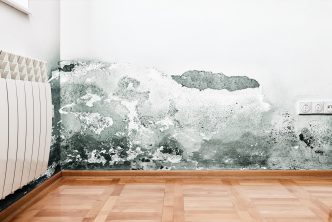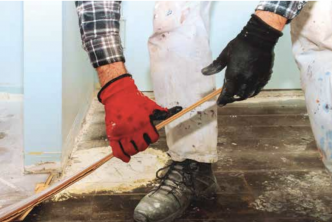by Kendra Budd, Associate Editor
Today, there are entire industries built around mold: testing for mold, cleaning up mold, preventing mold, and the list goes on. Indeed, among many restoration and remediation firms, mold is very frequently a central focus—or at the very least—a key concern.
However, the American public (and its insurance companies) was not always so concerned about mold.
It was only two decades ago when a landmark lawsuit involving mold captured national attention that mold became an outsized concern for insurance companies and an active part of the everyday public’s conversation. The result has been a plethora of businesses, technologies, services, industry standards and techniques to address mold detection and remediation.
So, what was the case that started it all? The lawsuit involved a home in Texas and, as you might have expected, an insurance company.
The case outlined a Texas home that was completely destroyed by mold, because an insurance company stalled on making repairs caused by water leaks.
This lawsuit sent shock waves through the nation, serving as the impetus for many State licensing laws, fundamentally changing how insurance companies deal with and address mold, and creating new industry standards and associations, such as NORMI, dedicated to training professionals how to deal with mold.
Here’s how it happened.
The Case
Anyone who knew Melinda Ballard knew how much she loved the iconic film, Gone with the Wind. So much so that her 12,000–square-foot Dripping Springs home was a replica of Tara, the mansion from the aforementioned movie.
In 1998, Ballard and her husband, Ron Allison experienced a plumbing leak in their bathroom, which was “fixed” soon after. However, according to Court documents of Ballard v. Fire Insurance Exchange (FIE), the house’s hardwood floor began buckling shortly after repairs.
Richard Roberts, Ballard’s flooring contractor, first suggested removing several floor boards to allow for dry out. However, a month later, Roberts then advised Ballard to contact her insurance company because moisture readings showed no signs that dry out occurred, and the damage to the floor was severe. Heeding Roberts’ warnings, the family filed a claim with FIE, whom Ballard held a policy with since 1992.
According to Ballard, a claims adjuster came out to their home and performed an inspection. The adjuster chalked up the damage to “slab settling” which was not covered under Ballard’s homeowner’s policy. The adjuster also concluded there were no plumbing leaks after testing for them. However, Ballard was far from satisfied and demanded another inspection. A month later, a FIE engineer and second adjuster found the damages were in fact caused by not one, but two water leaks. However, both claimed the leaks were no longer active in the home.
Roberts cautioned the adjuster about the potential dangers of mold growth if they refused to remove the hardwood and sub flooring. The warning was allegedly ignored by FIE.
In fact, Ballard asked for permission to remove the flooring herself in an attempt to mitigate the damages. Instead FIE rejected the request, directing her to only remove the floor boards with severe damage, and to cover the sub-flooring with carpet remnants or plywood while the claim was investigated. This went directly against Ballard’s policy, which allows for the homeowner to mitigate damages. However, the policy also outlines that the homeowners “must cooperate” with what the insurance company decides. FIE even threatened Ballard with the loss of her coverage if she made any repairs during the investigation.
In early 1999, soon after the second inspection, the couple and their 3-year old son began to experience a nightmare.
The windows, door frames, stairs and walls began cracking and buckling just as the floor had from water damage. Two months after the initial claim, FIE offered a payment of $108,000 to Ballard, but Ballard rejected the offer as insufficient to repair all of the damage.
To make matters worse, the family began to experience unexplained flu-like symptoms, including coughing up blood. In April, Ballard by chance met an indoor air quality consultant, Bill Holder, on a flight. She told Holder about the damage, as well as the symptoms her family was experiencing. He was the first to suggest the house may have been contaminated with mold.
Days later, Holder tested Ballard’s home for mold spores. Samples showed that mold was indeed present in the home, including stachybotrys, a toxic mold that is known to cause health problems. The family then hired scientists from Texas Tech University to also test their home. They confirmed the presence of the toxic mold spores as well. Ballard, Allison and their son had no choice but to move out.
Ballard and Allison hired a lawyer by this time, and although Farmers tried to make sizable offers to settle the claim, starting at just over $100,000, and then later offering over $380,000, but Ballard and Allison still filed a lawsuit against FIE in short order.
In their lawsuit, Ballard and Allison demanded $100 million in restitution both for damages to their home, and their health. The jury ultimately found that the house itself was damaged beyond repair. Pictures at the time of the trial show mold growth on the windows of the home, and cracks everywhere. The home would need to be demolished and rebuilt. However, while Ballard and Allison prevailed on the damage claims, Judge John Dietz ruled that medical testimony on health effects of mold could not be introduced because of the level of scientific proof required by a Texas Supreme Court, at the time of the case.
This was a huge blow to Ballard and her family, because since moving out of the home in 2000, Allison had been diagnosed with “toxic encephalopathy,” a form of brain damage due to mycotoxin poisoning. It is presumed that the poison was emitted from the stachybotrys. Allison, formerly a financial advisor, was now unable to work and suffering seizures regularly. Allison would later go on to file his own lawsuit against FIE, separate from his wife’s.
In Ballard’s case, she was awarded a judgment that sent shock waves through the insurance industry. The family was reportedly awarded $6.2 million in actual damages, $5 million for mental anguish, $12 million in punitive damages and $8.9 million to cover lawyer’s—totaling $32 million awarded to the family. Thus, becoming one of the biggest cases in the nation where a Court ordered an insurance company to pay damages in a toxic mold case.
Unfortunately for Ballard, the initial verdict was appealed in 2002, and the court lowered the cost to $4 million in actual damages. But Ballard refused to go out without a fight, and appealed that verdict as well. In March 2004, appeals were once again pending before the Texas Supreme Court, but both sides reached an undisclosed settlement before the trial began.
Despite this case being settled, it was a turning point in how we treat mold cases and has influenced both the insurance and restoration industries. But why did it take so long for the conversation to start? Well, mold and fungi weren’t always such an issue for the public.
An Insurance Claim’s Issue
When Ballard’s case was made national, insurance companies across the country immediately went to their state legislatures and tried to get mold exclusions to be allowed in their policies. This brought forth an explosion of insurance page 27
companies changing their policies, putting new rules in place, and conducting further training—just to avoid a potential Ballard-like case. Insurance companies also began seeking out contractors who had experience and specialized in water loss and mold cleanup.
Ballard was far from the first to sue an insurance company for mold infestation in the home, but she was one of the first to win against them. Even still, mold in the home is a much newer issue than people realize.
Mold wasn’t on people’s radars until the 1940s when it first began appearing in the home. The need for faster and more affordable construction popularized the use of drywall, which is composed of gypsum between two layers of durable paper. Gypsum easily absorbs water, and dries slowly. Meanwhile the paper is known for being conducive for mold growth. In just 24 to 48 hours of a water leak, a home’s drywall can easily become infested with mold.
Alongside the increasing use of drywall to build houses and apartment complexes faster, buildings also began to be built much more “tight.”
“Ever since the fuel crisis in the ‘70s, there has been a huge push to reduce energy usage and create a more comfortable living environment. We have walls stuffed thick with fluffy insulation,” writes Jason Earle in his article A Brief History of Mold. And since there is little air exchange in most homes, it makes it easier for any pollutant to build up and concentrate.
Yes, mold is invasive, especially in newer buildings, but it’s only when left untreated that it becomes an issue. On multiple occasions, Ballard had tried to get FIE to take her water leak seriously, but they continued to ignore her. Mold, in this case, was arguably the result of poor remediation practices. In fact, during the trial, the first adjuster admitted under oath that they lied to Ballard about not finding any water leaks. This is why the jury awarded the verdict that they did. Not just because of mold, but because of the lack of good faith from the adjuster and FIE.
Since the litigation of her case, many have since questioned whether Ballard’s case was more about how her claim was handled instead of the mold itself.
Nonetheless, fear of mold began to take over the industry. Once the case made headlines, the use of mold exclusions in homeowners’ insurance exploded nearly overnight, with insurance carriers rushing to their state insurance departments seeking approval to exclude mold within their state-approved insurance policies.
The exclusion of mold in professional and general liability (GL) business insurance policies was also popularized, which is a reason why the majority of contractors’ GL insurance policies exclude mold. For example, restoration contractors have to either (A) buy a separate policy covering them for mold, or (B) purchase their insurance through a broker that specializes in restoration and remediation firms that can provide the general liability and mold coverage in a single policy (Shop OREP.org/RR for coverage designed specifically for remediation/restoration professionals).
All of these changes in coverage and policies were specifically designed to eliminate, or severely limit, any pay-outs related to mold—which has become a scary, “bad” word in the insurance industry because of the Ballard judgment.
At the same time, insurance companies also tried to change how they responded to mold cases, seeking out contractors with experience remediating mold and ultimately creating increased demand for restoration and remediation services, as well as more uniform industry standards. In this way, Ballard’s case served as a catalyst that changed how the insurance industry perceived mold—and consequently kicked off the mold “revolution”—the rapid expansion of technologies surrounding mold testing, cleanup, and prevention, the push to license remediation professionals, the popularization of remediation and restoration industry standards and associations (NORMI et al.), and much more.
Mold Remediation Takes Off
The first point of controversy in this new and growing industry was to determine how mold could be (if at all) successfully eradicated in a home. Part of this was due to the fact that in the early days of this industry there was a huge debate over which sampling techniques were most appropriate.
The development of the mold remediation industry was parallel to the introduction and acceptance of spore trap samples. Beforehand, the traditional method was culture sampling using petri dishes. Nowadays, we have several different sampling system options like Environmental Relative Moldiness Index (ERMI), Health Effects Roster of Type Specific Formers of Mycotoxins and Inflammagens (HERSMI), Environmental Mold & Mycotoxin Assessment (EMMA), and InstaScope, provided to remediation professionals. In addition to sampling techniques, technology and tools available to test for, remove, and prevent mold have been increased exponentially since the late 1990s.
Licensing
However, despite the rapid growth in mold testing and remediation technology, only a handful of states currently require licensing for remediation. Douglas Hoffman, director of the National Organization of Remediators and Mold Inspectors (NORMI) is attempting to change that.
Hoffman explains how licensing for mold followed shortly after the Ballard case. “The first place to put in mold remediation licensing was Louisiana in July of 2004.” Texas followed soon after but it wouldn’t be until 2009 that other states would follow, Hoffman tells us. Those states are Florida and New York, and the District of Columbia adds to that. Portland, OR has also begun to require licensing within its city limits.
To make matters even more complicated, each has different requirements or policies put into place. Hoffman explains, “Florida requires 4 years of education—either a GED or High School Diploma— exams, a criminal background check, and an application with a fee.” D.C., however, requires a certificate for mold remediation on top of training. “These licenses aren’t transferable either,” Hoffman says. “If you want a license in Florida, but only have one for Portland, you’ll have to go through the proper channels to get that license again.”
One of the benefits of licensing is it establishes industry standards for contractors to abide by, which lowers liability for the professionals (you) and sets clear expectations for all involved. “We’ve seen time and time again scam artists take advantage of homeowners,” Hoffman says. As the industry has seen in the past, unlicensed or inexperienced contractors can perform shoddy work that allows mold to continue to grow in a home. Not only that, but it gives contractors a bad rap. “When licensing is done, and done correctly then we have an extra safety net,” argues Hoffman.
However, one of the reasons we don’t see many states requiring licensing is because of the economic impact it may have on the industry. “When Florida’s licensing laws first went into effect, it was rejected three times by the existing Governor. This was because they didn’t have a grandfather clause in the statute.” A Grandfather clause allows someone who is already working in the industry to obtain a certification and then bypass all those statutory requirements and get licensed. Without that clause the Governor was worried the industry would take a dip. However, the law was later passed by a different Governor.
Another reason state licensing hasn’t taken hold yet, Hoffman theorizes, is that there are still no federal guidelines for mold safety. That distinction has been left up to remediators and scientists for the past century, meaning there is no one guideline to go by. “Because there are no federal guidelines, like with lead or asbestos, the states are scrambling to write a regulation that will hold up in court,” Hoffman explains. States just aren’t sure how to word these guidelines that will then be regulated by the federal government.
Lastly, Hoffman believes part of the problem of why licensing is taking so long is because of who is given a voice and who isn’t. “Lawyers should not be writing these laws. Someone in the industry should,” Hoffman says. NORMI wants a seat at the table and to be a stakeholder in these conversations. The lack of mold professionals being included in regulation is perhaps the reasonit’s taking so long for these laws to take effect, Hoffman suggests.
Final Thoughts
As we reflect on the Ballard case, we can see that insurance companies responded to it with a combination of (1) reducing mold exposure by excluding it in their insurance policies, and (2) seeking more experienced, specialized contractors who have experience dealing with water loss claims and cleaning up and preventing mold growth in homes.
This shift in the insurance industry’s perspective of mold and increased awareness (and fear) of mold, along with a demand for professional cleanup services—helped the restoration and remediation profession grow into what it is today.
While it remains to be seen whether further licensing will be enacted in the remaining states, it is clear that mold growth in the home is a problem that both contractors and the consumer public will continue to face. In fact, we are still seeing cases like Ballard’s today. Just last year (2021), a jury in Florida awarded a woman $48 million for sickness caused by mold growth in her home.
As you already know, mold remains a highly contentious (and litigious) item in the United States. Stay safe out there!





